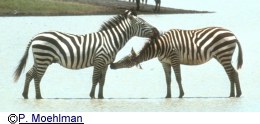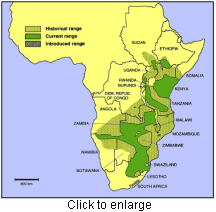Plains Zebra
Equus quagga
LC

Taxonomic Authority: Boddaert, 1785
Synonyms Common names
Equus burchellii Schinz, 1845
Plains Zebra - English (Primary)
Burchell's Zebra - English
Common Zebra - English
Painted Zebra - English
Punda Milia - Swahili
The Plains Zebra exhibits a morphological and genetic cline from north to south across its range (Groves and Bell 2004; Lorenzen 2008). Research has now firmly established that the extinct Quagga is a subspecies of the Plains Zebra (Rau 1978; Higuchi et al. 1984; George and Ryder 1986; Leonard et al. 2005). However, this view is in opposition to some morphological evidence (e.g., Bennett 1980; Klein and Cruz-Uribe 1999). Groves and Bell (2004) recognized six subspecies, based on coat patterns, skull metrics, and the presence or absence of a mane and of the infundibulum on the lower incisors (intergrades are observed). A recent genetic study analyzed 17 Plains Zebra populations, representing five of the six subspecies recognized by these authors (Lorenzen et al. 2008). The study found very little differentiation among populations. In fact, populations across the entire species distribution range were less differentiated than Namibian populations of Hartmann's Mountain Zebra. The five sampled Plains Zebra subspecies, which included the extinct Quagga, could not be distinguished with the genetic markers used and no genetic structuring was found indicative of distinct taxonomic units. The molecular data represented a genetic cline and was differentiated along an east-to-south gradient in agreement with the progressive increase in body size and reduction in stripes towards the south. This is consistent with the overlapping morphological parameters and geographical distribution of subspecies reported in literature. Hence, the subspecies splits based on the morphological cline may be arbitrary, but are useful from a management perspective.
General Information
Distribution

Plains Zebra range from southern Sudan and southern Ethiopia, east of the Nile River, to southern Angola and northern Namibia and northern South Africa (formerly ranging south of the Orange and Vaal Rivers to the Cape) (Hack et al. 2002; Klingel in press). They are now extinct in two countries in which they formerly occurred: Burundi and Lesotho. There is no information on their status in Angola, where they may also be extinct.
The six morphologically defined subspecies are distributed as follows (following Groves and Bell 2004, and Klingel in press):
E. q. crawshaii (Crawshay's Zebra) occurs in Zambia, east of the Luangwa River, Malawi, south-eastern Tanzania from Lake Rukwa east to Mahungoi, and Mozambique as far south as the Gorongoza district;
E. q. borensis ranges in north-west Kenya, from Guas ngishu and Lake Baringo, to the Karamoja district of Uganda and south-east Sudan, east of the Nile River to the northern limit of the species at 32°N;
E. q. boehmi (Grant's Zebra or Boehm's Zebra) is found in Zambia, west of the Luangwa River, west to Kariba, Shaba Province of DR Congo north to Kibanzao Plateau; Tanzania north from Nyangaui and Kibwezi into south-west Uganda, south- west Kenya as far as Sotik, and east Kenya, east of the Rift Valley, into southern Ethiopia and perhaps to the Juba River in Somalia.
E. q. chapmani (Chapman's Zebra) ranges from north-east South Africa, from about 24°S, 31°E, north to Zimbabwe, west into Botswana at about 19°S, 24°E, the Caprivi Strip in Namibia, and southern Angola;
E. q. burchellii (Burchell's Zebra) formerly occurred north of the Vaal/Orange Rivers, extending north-west via southern Botswana to Etosha National Park and the Kaokoveld, south-east to KwaZulu-Natal and Swaziland. It is now extinct in the middle of its range. E.b. antiquorum is now included in this subspecies;
E. q. quagga (Quagga) occurred in the former Cape Province, south of the Orange and Vaal Rivers and west of the Drakensberg. Now extinct.
Population
Plains Zebra are locally common throughout their range both in and also outside protected areas (especially in Kenya and
Tanzania). Total numbers were estimated at about 660,000 in 2002 (Hack et al. 2002). Over 75% of the world's Plains Zebra are of the
Grant's subspecies (E. q. boehmi), with some 200,000 in the greater Serengeti/Mara ecosystem; Serengeti National Park
supports the world's single largest Plains Zebra population (151,000) (East 1997; Hack et al. 2002). Current information on total
population size is limited. Aerial survey data from Tanzania indicate that there may have been a population decline of
approximately 20% from the late 1990s to the mid-2000s (Hack et al 2002; TAWIRI/TWCM pers comm. 2008).
The True Quagga subspecies (E. q. quagga) has been extinct since the end of the 19th century (ca. 1883).
Recorded densities of Plains Zebra include 0.9/km2 in Kruger National Park (Smuts 1976) and 22/km2 in Ngorongoro (ground count) (Klingel 1967).
Habitat and Ecology
Plains Zebra live in all habitats in Africa from sea level to 4,300m on Mount Kenya, with the exception of rain forests, deserts, dune
forests, and Cape Sclerophyllous vegetation (Duncan 1992; Klingel in press). Plains Zebra are selective grazers, and in the
Serengeti Grogan's (1973) research indicated that Pennisetum mezianum was a preferred species. He compared
proportions ingested to their availability in the sward and found that there was significant selection and rejection of grass species.
In several areas, their movements are directly correlated with the availability of water, moving to grazing areas during the rains and concentrating near permanent rivers or pools during the dry season. The Serengeti migratory subpopulation concentrates during the rains from November to May in the Serengeti plains. At the beginning of the dry season in June it migrates to the western and northern parts of the Serengeti National Park and adjacent areas, and into the Mara National Reserve in Kenya (Klingel in press).
Threats
No major threats appear to be resulting in range-wide population declines, but habitat loss and overhunting are resulting in
localized declines in some areas. Although no country within this species' range is free of either problem, loss of habitat appears to
be more of a concern in the southern half of the range, while poaching appears to be more significant in the northern half.
Nonetheless, the Plains Zebra is a relatively resilient species that has demonstrated a remarkable ability to recover from population
declines when provided with suitable habitat and protection from overhunting (Hack et al. 2002).
The Quagga was driven to extinction in the late 19th century by overhunting and competition with livestock.
Conservation Measures
Plains Zebra occur in numerous protected areas across their range, including the Serengeti National Park (Tanzania), Tsavo and
Masaai Mara (Kenya), Hwange National Park (Zimbabwe), Etosha National Park (Namibia), and Kruger National Park (South
Africa).
Hack et al. (2002) proposed the following conservation actions for the species: 1) Improve coverage and frequency of monitoring; 2) Improve risk assessment; 3) Quantify and manage genetic diversity both globally and locally; 4) Increase the understanding of the species' basic biology'; and 5) Investigare the economics of alternative utilization stategies.
IUCN Red Listing
Red List Assessment: (using 2001 IUCN ) Least Concern (LC)
Rationale for the Red List Assessment
Listed as Least Concern as the species as a whole remains widespread, common, and there are no major threats resulting in a
range-wide population decline.
Bibliography
Bennett, D.K., 1980, Stripes do not a zebra make. A cladistic analysis of Equus., Systematic Zoology, 272-287, ,
Duncan, P., 1992, Zebras, Asses and Horses: an Action Plan for the Conservation of Wild Equids, , IUCN, Gland and Cambridge
East, R., 1997, Current status of Burchell's Zebra in Africa, with additional information on Grevy's Zebra and Cape Mountain Zebra., Report to IUCN/SSC Equid Specialist Group, 42, ,
George, M. and Ryder, O.A., 1986, Mitochondrial DNA evolution in the genus Equus., Molecular Biology and Evolution, 535-546, ,
Grogan, P.J.P., 1973, Some Aspects of Nutrient Utilization by Burchell's zebra (Equus burchelli bohmi MATSCHIE) in the Serengeti-Mara region, East Africa. MSc thesis. Texas A&M University, College Station , Texas. 84pp., , ,
Groves, C.P. and Bell, C.H., 2004, New investigations on the taxonomy of the zebras genus Equus, subgenus Hippotigris., Mammalian Biology, 182-196, ,
Grubb, P., 2005, Order Perissodactyla, Mammal Species of the World, D.E. Wilson;D.M. Reeder, 629-636, The Johns Hopkins University Press, Baltimore
Hack, A.M., East, R., Rubenstein, D.I., 2002, Status and Action Plan for the Plains Zebra, Equids: Zebras, Asses and Horses. Status Survey and Conservation Action Plan, Patricia D. Moehlman, 43-60, IUCN, Gland
Higuchi, A., Bowman, B., Freiberger, M., Fyder, O.A. and Wilson, A.C., 1984, DNA sequences from the quagga, an extinct member of the horse family, Nature312, 282-284, ,
Klein, R.G. and Cruz-Uribe, K., 1999, Craniometry of the genus Equus and the taxonomic affinities of the extinct South African quagga., South African Journal of Science, 81-86, ,
Klingel, H., 1967, Soziale Organisation und Verhalten freilebender Steppenzebras., Zeitschrift für Tierpsychologie, 580-624, ,
Klingel, H., in press, Equus quagga, The Mammals of Africa. Vol. 5. Carnivores, Pangolins, Rhinos and Equids., Kingdon, J.S. and Hoffmann, M., , Academic Press, Amsterdam
Leonard, J.A., Rohland, N., Glaberman, S., Fleischer, R.C., Caccone, A. and Hofreiter, M., 2005, A rapid loss of stripes: the evolutionary history of the extinct quagga., Biology Letters, 291-295, ,
Lorenzen, E.D., Arctander, P. and Siegismund, H.R., 2008, High variation and very low differentiation in wide ranging plains zebra (Equus quagga): insights from mtDNA and microsatellites. Molecular Ecology 17(12): 2812-2824., , ,
Rau, R.E., 1978, Additions to the revised list of observed material of the extinct Cape Colony quagga and notes on the relationship and distribution of southern plains zebras., Annals of the South African Museum, 27-45, ,
Rubenstein, D.I., 1986, Ecology and sociality in horses and zebras., Ecological Aspecits of Social Evolution, D.I. Rubenstein and R.W. Wrangham, 282-302, Princeton University Press, Princeton
Smuts, G.L., 1976, Population characteristics of Burchell's Zebra (Equus burchelli antiquorum, H. Smith, 1841) in the Kruger National Park, South African Journal of Wildlife Research, 99-112, ,



